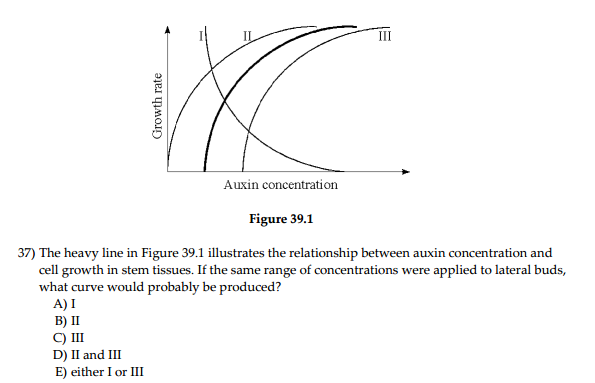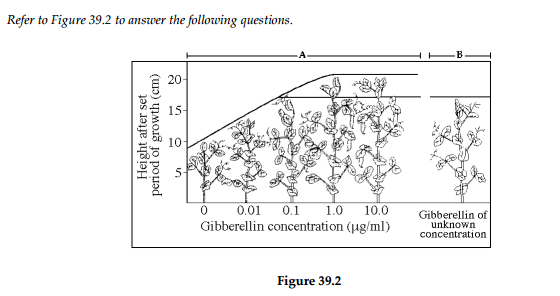Instructions for Side by Side Printing
- Print the notecards
- Fold each page in half along the solid vertical line
- Cut out the notecards by cutting along each horizontal dotted line
- Optional: Glue, tape or staple the ends of each notecard together
AP Biology Chapter 39
front 1 ) Charles and Francis Darwin concluded from their experiments on
phototropism by grass | back 1 A |
front 2 Plants growing in a partially dark environment will grow toward light
in a response called | back 2 D |
front 3 Which of these conclusions is supported by the research of both Went
and Charles and | back 3 C |
front 4 We know from the experiments of the past that plants bend toward
light because | back 4 C |
front 5 Which of the following is not presently considered a major mechanism
whereby hormones | back 5 A |
front 6 Evidence for phototropism due to the asymmetric distribution of auxin
moving down the | back 6 A |
front 7 According to modern ideas about phototropism in plants, | back 7 E |
front 8 A plant seedling bends toward sunlight because | back 8 D |
front 9 The apical bud of a pine tree inhibits the growth of lateral buds
through the production of | back 9 E |
front 10 After some time, the tip of a plant that has been forced into a
horizontal position grows | back 10 E |
front 11 ) Negative gravitropism of plant shoots | back 11 E |
front 12 The ripening of fruit and the dropping of leaves and fruit are
principally controlled by | back 12 D |
front 13 ) Which one of the following is not a direct function of either auxin
or gibberellin? | back 13 A |
front 14 Which of the following statements about plant hormones is
false? | back 14 B |
front 15 The plant hormone involved in aging and ripening of fruit is | back 15 B |
front 16 When growing plants in culture, IAA is used to stimulate cell
enlargement. Which plant | back 16 D |
front 17 Why do coleoptiles grow toward light? | back 17 D |
front 18 Plant growth regulators can be characterized by all of the following
except that they | back 18 C |
front 19 ) Plant hormones produce their effects by | back 19 D |
front 20 Why might animal hormones function differently from plant
hormones? | back 20 E |
front 21 Buds and sprouts often form on tree stumps. Which of the following
hormones would you | back 21 B |
front 22 Plant hormones can have different effects at different
concentrations. This explains how | back 22 D |
front 23 Auxins (IAA) in plants are known to affect all of the following
phenomena except | back 23 B |
front 24 How does indoleacetic acid affect fruit development? | back 24 D |
front 25 ) Oat seedlings are sometimes used to study auxins because | back 25 D |
front 26 Auxin triggers the acidification of cell walls that results in rapid
growth, but also stimulates | back 26 C |
front 27 Which plant hormones might be used to enhance stem elongation and
fruit growth? | back 27 B |
front 28 Which of the following has not been established as an aspect of
auxinʹs role in cell | back 28 B |
front 29 Cells elongate in response to auxin. All of the following are part of
the acid growth | back 29 D |
front 30 According to the acid growth hypothesis, auxin works by | back 30 D |
front 31 Which of the following hormones would be most useful in promoting the
rooting of plant | back 31 E |
front 32 Which plant hormone(s) is (are) most closely associated with cell
division? | back 32 B |
front 33  | back 33 A |
front 34 The synthesis of which of the following hormones would be a logical
first choice in an | back 34 C |
front 35  The results of this experiment, shown on the left of the graph (area
A), may be used to | back 35 D |
front 36  This experiment suggests that the unknown amount of gibberellin in
the experimental plant | back 36 C |
front 37 One effect of gibberellins is to stimulate cereal seeds to
produce | back 37 E |
front 38 In attempting to make a seed break dormancy, one logically could
treat it with | back 38 D |
front 39 Ethylene, as an example of a plant hormone, may have multiple effects
on a plant, | back 39 D |
front 40 If you were shipping green bananas to a supermarket thousands of
miles away, which of | back 40 C |
front 41 Which of the following is currently the most powerful method of
research on plant | back 41 E |
front 42 We tend to think of plants as immobile when, in fact, they can move
in many ways. All of | back 42 B |
front 43 Auxin is responsible for all of the following plant growth responses
except | back 43 D |
front 44 Incandescent light bulbs, which have high output of red light, are
least effective in | back 44 C |
front 45 ) Both red and blue light are involved in | back 45 A |
front 46 ) Seed packets give a recommended planting depth for the enclosed
seeds. The most likely | back 46 C |
front 47 A short-day plant will flower only when | back 47 D |
front 48 A flash of red light followed by a flash of far-red light given
during the middle of the night | back 48 B |
front 49 Many plants flower in response to day-length cues. Which statement
concerning flowering | back 49 C |
front 50 Which of the following does not reduce the level of the Pfr form of
phytochrome? | back 50 B |
front 51 ) Most plants close their stomata at night. What color of light would
be most effective in | back 51 C |
front 52 The houseplants in a windowless room with only fluorescent lights
begin to grow tall and | back 52 C |
front 53 ) In legumes, it has been shown that ʺsleepʺ movements are correlated
with | back 53 B |
front 54 Biological clocks cause organisms to perform daily activities on a
regular basis. Which of | back 54 D |
front 55 The biological clock controlling circadian rhythms must
ultimately | back 55 B |
front 56 Plants often use changes in day length (photoperiod) to trigger
events such as dormancy | back 56 A |
front 57 If the range of a species of plants expands to a higher latitude,
which of the following | back 57 B |
front 58 In nature, poinsettias bloom in early March. Research has shown that
the flowering process | back 58 D |
front 59 A botanist exposed two groups of the same plant species to two
photoperiods–one with 14 | back 59 E |
front 60 What does a short-day plant need in order to flower? | back 60 D |
front 61 If a short-day plant has a critical night length of 15 hours, then
which of the following | back 61 D |
front 62 A long-day plant will flower if | back 62 D |
front 63 Plants that have their flowering inhibited by being exposed to bright
lights at night are | back 63 D |
front 64 ) Plants that have their flowering inhibited by being exposed to
bright lights at night are | back 64 D |
front 65 Classic experiments suggested that a floral stimulusFlorigencould
move across a graft | back 65 B |
front 66 In general, which of the following is not a plant response to
herbivores? | back 66 A |
front 67 ) In order for a plant to initiate chemical responses to
herbivory, | back 67 B |
front 68 Plants are affected by an array of pathogens. Which of the following
is not a plant defense | back 68 E |
front 69 A pathogenic fungus invades a plant. What does the infected plant
produce in response to | back 69 B |
front 70 ) Which of the following are defenses that some plants use against
herbivory? | back 70 D |
front 71 The transduction pathway that activates systemic acquired resistance
in plants is initially | back 71 C |
front 72 Which of the following are examples or parts of plantsʹ systemic
acquired resistance against | back 72 E |
front 73 A plant will recognize a pathogenic invader | back 73 D |
front 74 What is the probable role of salicylic acid in the defense responses
of plants? | back 74 B |
front 75 When an arborist prunes a limb off a valuable tree, he or she usually
paints the cut surface. | back 75 D |
front 76 Which of the following is not a typical component of a signal
transduction pathway? | back 76 A |
front 77 Auxin enhances cell elongation in all of these ways except | back 77 C |
front 78 Charles and Francis Darwin discovered that | back 78 D |
front 79 Which hormone is incorrectly paired with its function? | back 79 B |
front 80 ) The hormone that helps plants respond to drought is | back 80 E |
front 81 ) The chemical signal for flowering could be released earlier than
normal in a long-day plant | back 81 B |
front 82 If a long-day plant has a critical night length of 9 hours, which
24-hour cycle would | back 82 B |
front 83 If a scientist discovers an Arabidopsis mutant that does not store
starch in plastids but has | back 83 C |
front 84 How may a plant respond to severe heat stress? | back 84 E |
front 85 In systemic acquired resistance, salicylic acid probably | back 85 B |